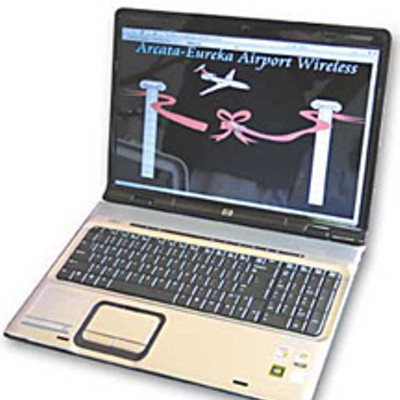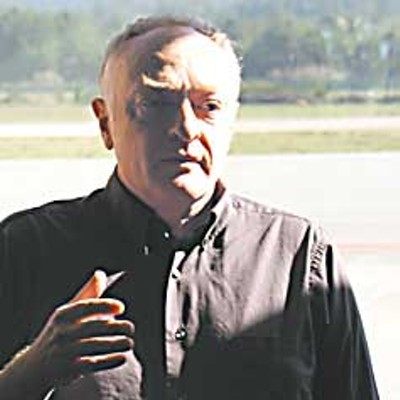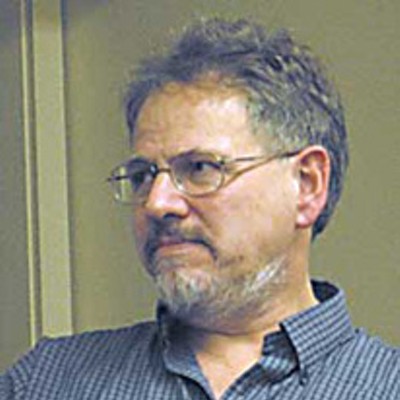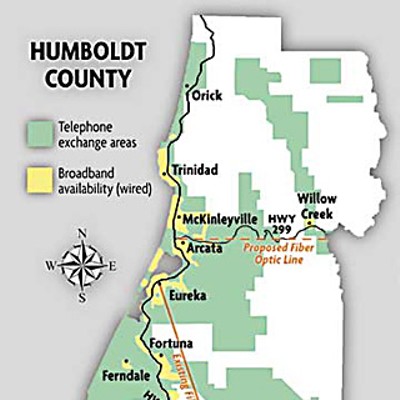The cream-colored box marked "RuralConnect™Trailblazer™" is just a display model mounted on a telescoping pole in the large, dark garage in what was once the Arcata headquarters of Yakima, now home to Carlson Wireless Technologies Inc. It's one element in an exhibit the company is assembling for an upcoming telecom trade show. The square, gunmetal gray device at the top of the pole doesn't look like a microwave antenna, but that's what it is. With a little imagination you can place them where they would really be employed: on some windswept mountaintop at the edge of wired civilization, mounted on a lonely pole or perhaps even on a tree.
"It's called the master, or the line termination," says Jim Carlson, as he shows a reporter around the facility. "It's used at the end of the phone lines, up on a ridge or some place at the end of the telephone company's service. There might be a ranch in another canyon five miles away, or even 10 or 20, where they'd like to have phone service and Internet. You point the antenna over to the ranch and it saves obtaining rights of way, running wires, digging trenches for five to 20 miles. The particular product is designed for isolated areas that are geographically unobtainable due to some obstacle."
It's something of a cliché at this point, but we are living in a digital age, a time when information is the hot commodity. Computers are being reconfigured as entertainment delivery devices bringing a world of news, music and movies to us at the touch of a button. Telecommuting has become commonplace. Distance learning and telemedicine are on the rise. It's a time when, at least in theory, you can live and work wherever you want, connecting with the rest of the world via that vast web we call the Internet to share in the digital revolution.
The trouble is, not everyone has equal access to this wave of the future. Particularly in California, telecom companies crisscrossed urban areas with fiber-optic cable during the silicon gold rush at the end of the '90s, laying so much, in fact, that we know have what's know as "dark cable," unused for lack of demand. Such was not the case in rural areas like Humboldt, where a full fiber connection wasn't available until late in 2003. Even today, high-speed Internet service - broadband - is only available in the 5-10 percent of the county within reach of the 101 corridor, where the fiber runs.
How can we bring broadband to the rest of the county? Wireless connections would seem to be a likely solution, and we're not talking about the kind of wireless you use at the coffeeshop downtown.
At the airport
The backwoods digital divide was not what was on people's minds at the Arcata Airport on a recent Wednesday morning. The high tech crowd and a couple of county supervisors, Bonnie Neely and John Woolley, were there to celebrate the completion of a free Wi-Fi system serving the airport, one of just seven free systems in airports around the United States.
A TV crew and a couple of reporters were on hand to record the event for posterity as speeches were made. In his remarks Scott Joachim, whose firm, C4I Security, installed the system, proclaimed, "There's no reason why we should settle for less technology just because we're behind the Redwood Curtain."
Bob Morse was enlisted to cut a virtual ribbon with virtual scissors on a laptop hooked into the Wi-Fi system. He sits on the board for the local tech advocacy organization, Redwood Technology Consortium, which worked with airport management to facilitate the project. "OK, happy surfing!" he announced, ending the ceremony.
Morse and his wife Marianne run Morse Media, a Eureka-based multi-media development company. (Among other things the company provides hosting service for the North Coast Journal website.) He also hosts a blog, Talking Tech, with "notes related to tech issues and life on the North Coast of California." Before he headed back to his home office, we asked about the state of broadband connectivity in Humboldt.
"Obviously all the densely populated areas have pretty good access," he began. "Although once you get outside Eureka, certain pockets even close in do not have DSL or cable - they just don't go out there. If you go out further beyond the highly populated areas broadband drops off very rapidly, as does the population, so there's some logic to that. The ideal is to be able to spread broadband everywhere."
How might that happen? "There are a lot of possibilities, some via fiber, some wireless, some by satellite, I suppose, if we have to," Morse concluded.
What is broadband?
Before we move on, it might be best to pause and consider this word we've been throwing around: broadband. Broadband Internet access is available locally over a variety of platforms including cable modems, digital subscriber lines (DSL), both tapping into the fiber Morse mentioned, along with wireless and satellite.
Broadband is a relative term used to describe an always-on communication link fast enough to move large digital files more quickly than what was commonly used way back in the 20th century: phone lines and "dial-up" phone modems that deliver data at 56 kbps (kilobits per second).
How much faster in broadband? "It depends on who you talk to," says Tina Nerat, another RTC boardmember.
The Federal Communications Commission (FCC) defines broadband as delivery of 200kbps, a little less than four times faster than dial-up.
"That's pretty low," says Nerat. "I think it's way too low. It's way outdated - I don't think it's changed for 10 years. Some think it should be a gigabit (1,000 Mbps), but for rural areas it's going to be something lower than that." (See chart.)
However it's defined, there's general agreement that access to broadband is a good thing, a key element in California's dream for a prosperous future.
As Governor Arnold Schwarzenegger put it in typical grandiose fashion, "The Golden State must remain competitive in the telecommunication revolution so that we can continue to attract the best, the brightest and the most creative workforce in the world. Broadband will help build California so we can grow our economy, create great jobs and stay ahead in the global marketplace."
The governor said this in announcing formation of the California Broadband Task Force, a panel that's supposed to figure out how "to remove barriers to broadband access, identify opportunities for increased broadband adoption, and enable the creation and deployment of new advanced communication technologies" throughout the state.
While the select group of 21 members seems dominated by politicians and high-powered executives from AT&T, Verizon, Cox Communications and Cisco Systems, there are two representatives on the task force from Humboldt County: Humboldt State President Rollin Richmond and Peter Pennekamp, executive director of the Humboldt Area Foundation. Both are quick to note that they are the only members who actually live in a rural area. Tina Nerat has been enlisted to serve as their sole staff member.
The head cheerleader
Nerat and her husband, Mike, run a consulting company called NeraTech out of an office in their spacious home in Eureka. She retired to Humboldt at the turn of the 21st century after a 26-year career as what she terms a "techie" in Southern California, providing I.T. (information technology) and engineering services to a wide range of companies. She says she was "shocked" at the level of connectivity she found when she moved here from Escondido in "rural San Diego."
"Like a lot of newcomers I just assumed we'd have the kind of service we had down south. Working with businesses and schools here, I'm still shocked at the state of the infrastructure: the cabling and internal wiring is 1980s-vintage in a lot of cases."
While she claims she "never expected to work again," she was "sucked back in" to the tech scene via her involvement with Redwood Technology Consortium and its battle for "ubiquitous broadband coverage in Humboldt County," as she puts it. She has become something like the head cheerleader for better broadband in Humboldt.
Her first big task: a 2002 report for the Small Business Development Center on the state of telecommunications. She found that "we weren't very connected, and we weren't going to get broadband out to new communities until the backhaul problem was solved. At that time there was no fiber to here, so we were at capacity."
This was the era of the infamous fiber optic gap, a 21-mile chasm in the fiber between Redway and Scotia left incomplete for years while the California Department of Transportation (Caltrans) and phone company, SBC (formerly Pacific Bell), argued in court over right-of-way fees. A fiber system was growing in the greater Humboldt Bay region, but all digital data was being relayed via a system of microwave antennas.
RTC mounted a high profile campaign applying pressure in Sacramento and eventually SBC gave in, at least long enough to bridge the fiber gap.
Nerat noted that once the connection was complete and the system switched over fiber, "a lot of people thought we were done. We were done with that, but now we have to think about redundancy and how we spread broadband out to other communities."
She figures it's not pure chance that brought Humboldt to the governor's Broadband Task Force table. "Because of what we went through with Caltrans and SBC, Humboldt is already on the radar all over the place. The fiber outages we've had recently added to that.
"We're used as a model of what rural communities can do as far as activism. We know what our telecom looks like here - a lot of counties don't, they haven't taken the time to do an assessment of what people want, what areas have it and don't."
She hopes the governor's task force may help move things forward. "It's brought a lot of people to the table: the telecoms (telecommunications companies), Cisco, people from different sectors like health care and education, rural areas and such. People are talking and there's an aggressive schedule for releasing reports. I think material things will come out of it in terms of policy: right-of-way, permitting, some issues that were problems for our area before."
Nerat is the rural rep on the Buildout Working Group (BOWG), a subcommittee of the governor's task force charged with expanding broadband coverage. Since the urban areas are saturated for the most part, that presumably means increasing access out in the boondocks.
"Rural is the have-nots, not only underserved, but unserved in most cases," she says. Also in the BOWG: ATT and Cox. "They're on the vendor side. They have a lot of ideas about how permitting can be streamlined. It's painful, expensive and time consuming. It has to be less painful for them."
But difficulty with permits is not what stops vendors from bringing broadband to isolated communities. It's a simple matter of economics: the infrastructure is costly; those costs must be recouped.
Nerat heard recently from a woman in Weott who was frustrated by her inability to get anyone to even consider bringing broadband to that small community.
"I told her to go around to her neighbors and get them to sign up - we'll find the right person at the phone company to talk to -- but they're not going to get anywhere by complaining."
In some cases it may simply be a matter of demonstrating that there's the critical mass of customers. "You need a community leader to take charge, to create a sense of urgency, get a list of people who want service, maybe even apply for a little grant funding to help with the upfront costs. You have to work with your telecom.
"Where you have clumps of people, communities like Weott or Miranda, you can probably get enough people together to figure out how to make the business case, but you also have to have enough people to sustain the system over time."
Connecting Orick
What's happening up in Orick - expansion of service through the airwaves, rather than with wires - may prove a model for bringing broadband to rural, underserved communities in Humboldt County. The fact that people are now talking about bringing a fast pipe to the little North Humboldt town is a miracle; not too long ago, there was no Internet in town at all.
"Even dial-up service was a long distance call there as recently as 2002," Nerat notes. "If you're trying to do business over a dial-up connection you could spend hundreds per month just for your Internet connection." Matters are complicated by the fact that Orick is in the service area for Verizon Northwest, the company that covers Del Norte County. AT&T's fiber ends at Trinidad.
Nerat, who had previously helped facilitate bringing a local dial-up number to the community, served as an "on-the-ground" contact in the planning process. "We came up with a list of 60-some people who wanted [broadband] service. The challenge is that they're spread out along 101 and over hills and such so there's not line of sight to all of them."
Nerat called Verizon asking if they would supply DSL service if the community came up with financing. "They said, No, we'd have to put fiber in from Crescent City and it would cost $10 million.' They basically said,Go away.'"
Instead the planning group's report proposes a community wireless network, dubbed Orick Net, that Nerat says, "would be sustainable at $60 a month - not cheap, but better than dial-up," and better than the satellite-based service that's currently the only broadband option.
"An interesting thing came out of this," Nerat noted. "I got a call from a guy from Willits, Mike Ireton, whose company Willits Online does wireless broadband for remote areas like Covelo and Laytonville. He already has a system in place, he has billing in place, so we're working with him. That might be the easiest way to get things going. Someone needs to take charge."
At least judging from the way he talks on the phone, Ireton is a gung ho, take-charge, can-do sort of guy. And he's raring to go. "We already have a large network and operating experience, plus the servers, the bandwidth, the tech support, the trucks, equipment, the contracts, all the stuff that makes an ISP work."
Ireton drove up to Orick from his office in Willits a couple of weeks ago to try to work out a deal based on their business plan. "I took the numbers and ran them through my cost structure and came up with something that seems sustainable. You have to make sure something like this is paying its own way. You can't have it based on a grant or government funding that will eventually run out."
Startup funding would be required however; something that he's hoping might come from some source like the Headwaters Fund. Once he gets the word, he figures it will only take a matter of weeks to implement.
"It's the same sort of thing we're doing in communities down here that are in the same boat. Building the system can actually be done in a couple of days. It's not that hard to do. The time consuming part is turning on the individual subscribers," setting up the end users, be they homes or businesses.
Ireton is a true believer when it comes to bringing high-speed access to the masses. "It's really simple. Broadband should be considered a right. I'm living proof that we can do this right now. You don't need million dollar tax breaks. All you need is the will to do it. You have the same problems up in Humboldt we had down here. I think we can do what we do here up there using the same technology, the same deployment methodology. Just say the word."
Hardware supplier
Jim Carlson is low-key compared to Ireton, but not less dedicated to bringing access to rural areas. He started his business over 20 years ago, before the Internet age came along, to provide phone service to off-the-grid homesteads in the hills of Southern Humboldt. "It might have been some family with maternity issues, or with older parents living with them - they needed to call a doctor. It was usually around emergency medical care. We served outlying areas where the phone service had no franchise - they had no other choice."
When the Internet came along and people asked for that level of service, Carlson designed new systems to accommodate new customers. "We do what the market demands; we simply find a way to do it," he says.
Carlson Wireless Technologies (CWT) doesn't just deal with remote ranches looking for a phone and an Internet connection (what's known as "point-to-point service"), although that's mostly what's in use here in Humboldt County. The company also manufactures systems with the power to hook a whole isolated community, with up to 120 phone lines, through a microwave transmitter.
CWT's new home in the abandoned Yakima building in Arcata's industrial zone only occupies a small portion of the vast building. Carlson leads the way through one big empty room after another, each with a large colorful mural by Duane Flatmo showing outdoorsy types engaged in sporty activities, their vehicles adorned with Yakima racks. Where there was once a bustling network of cubicles, all that's left behind a series of little plastic boxes attached to wires: idle telephone and computer connections. Carlson's business is growing, he can envision expanding to fill the place. "Not this year, some time," he says with some optimism. "We're setting the stage to be able to do it."
The conversation turns to the closure of the fiber gap and the campaign for redundant fiber, specifically a fiber line running east to Redding and the I-5 corridor to create what's called a ring of connectivity. "Those things don't do anything for the wider areas of Humboldt really, but they're important issues," says Carlson pausing to sip from a bottle of Dr. Pepper. "The Caltrans versus Pac-Bell battle really didn't make any sense. It got people's emotions up, and that seems to carry over to fighting the next fight, redundancy and ring topology, which does makes sense.
"But wireless development is a completely different thing and that's the key to serving remote areas of the county. Distribution is everything when it comes to enhancing access. There's a guy right now, Seth Johannesen, with 101Netlink, who is setting up wireless ISPs in the rural areas. He's getting his feet wet, getting experience. He also owns a backbone that's completely separate from AT&T, his own microwave feed. It's big - a lot of action, a lot of bandwidth."
Backwoods backbone
Johannesen is network manager for 101Netlink, a company that has been building a network "from mountaintop to mountaintop" for about seven years. Last February the Southern Humboldt-based business started selling bandwidth off its 150 Mbps microwave "backbone."
"A backbone is like an interstate freeway, a main route," Seth explained. "AT&T's fiber from the Bay Area to Eureka is a backbone with distributions off it; we have a backbone as well. As far as we know, we're the only other supplier of broadband connectivity to the North Coast."
The company currently offers a range of service along the corridor from Ukiah to Eureka. "We supply all of it," said Seth. "We supply wholesale broadband connections to other ISPs. We supply the cable company in Garberville (Wave Broadband, formerly Starstream Communications). We do wireless distribution to businesses. And we supply retail end users starting at $55 a month - that's based on a shared connection, a wireless service comparable to DSL or a cable modem."
101Netlink had also hoped to supply Suddenlink (formerly Cox) with a backup solution for when its fiber link goes down, but so far they're not biting.
"We have people out in Bridgeville with service, people in Fortuna, in Rio Dell. We don't hit Miranda or Weott; they have some issues with getting line-of-sight. We'll probably look at those markets once we've covered the markets we're already in."
In the case of a town like Weott, bringing in service will require building an intermediate microwave station, which as Johannesen notes, involves finding a landowner, looking at the power situation, and perhaps setting up a solar supply to set up a reliable station, one that will "hold up in the snow, the rain, the sun."
"If someone does the legwork in a community, says, `Hey, we have this many people wanting service,' that lets us know what to anticipate if we do a buildout to that community. When I inquired to Shelter Cove, they had done a survey."
With a list of definite and possible clients, 101Netlink knew they had potential for a viable business, a payoff for the investment in infrastructure.
As Nerat points out, the state might play a role in bringing service to underserved areas. Johannesen says he knows there are subsidies and grant funding out there. "We've looked into it - it's a gamble spending time trying to figure those things out. But if a community like Weott or Miranda got together to find funding, I'm sure it would really help them, and us. We look at the cost to get in, and there are other areas that don't require the same kind of investment."
Seth puts it in simple terms: "No business is going to provide wireless Internet access if it's not going to make money."
Where is 101Netlink headed? "We're going to keep going, building north. We anticipate putting more wireless Internet into Fortuna, Ferndale, Hydesville, Rio Dell and Scotia, and to the outlying areas that have line of sight. As we move into the more populated areas, there's more return, but there's also more competition from cable and DSL. Right now we have our ear to the ground trying to hear how people feel up north, if they're pleased or dissatisfied with the current services available."
Redundancy and the ring
The Boxing Day outage on Dec. 26, 2006, caused by winds taking the fiber out around Laytonville, and a second outage less than a month later caused by a house fire in Willits, showed the inherent weakness in what's termed "aerial" fiber. (Burying fiber in trenches is more costly.) It also renewed the call for a redundancy ring in the fiber system.
Not everyone agrees with that call, though. According to AT&T Northern California spokesperson Vanessa Smith, "AT&T network reliability [on the North Coast] meets or exceeds the reliability found in other parts of California."
Smith said the company is well aware of the fact that worries were raised by recent fiber outages. "Once the fiber route was impacted, we diversified our services over to [use] the microwave system. We are able to switch over voice services," to cover emergency numbers like 911, but not data transmission.
As to the call for redundancy, Smith was noncommittal. "We are always looking for ways to increase the backup bandwidth and investigating potential ways to build out our infrastructure," she said, adding, "We're doing feasibility studies looking at all the possible alternatives in the area."
While Johannesen does not discount the need for an eastbound fiber link to create a more reliable system, he says that's not the only way to go. "There's this outcry, `We need redundancy!' but fiber is not the only solution; it's not the only option," he says. "We could create enough capacity to create full redundancy for the North Coast. We're looking at how to do that.
"With wireless we can create that ring, in a different sense. The North Coast is not that big. We're not at San Francisco level of traffic. Fiber is the ideal transport - but with the way technology's going microwave could certainly handle most of the backhaul.
"We can come in with retail to businesses who want redundancy. The other way is for Suddenlink to buy a link from us, which would give them true redundancy. Getting AT&T to buy from us, I'm not even going to knock on that door. But if a group was formed to put pressure on AT&T to peer with 101Netlink, we'd be open to that. We think that's the logical way to create true redundancy almost immediately. I have the infrastructure in place to add more capacity, but I'm not going to expand until there's a demand."
It probably goes without saying that supply and demand are key when it comes to any business, and bringing better broadband access to rural regions is no exception. Getting a major telecom to team up with a small rural provider like 101Netlink may be a dream, especially since the company already has its own parallel microwave system.
But what people like Johannesen, Ireton, Nerat and Carlson are showing is that it doesn't take a mountain of federal or corporate money to get the boondocks properly online. And that's a good thing, too, because neither big government nor big telecom seems to show much interest in extending the reach of the Internet to anywhere but the urban centers. Once you take the wires out of the equation, though, anything's possible. The future of communications, at least in rural places like Humboldt County, is over the air. And it's the little guys who are leading the way.
*North Coast Telecom TimelineDATE*EVENT2000Limited DSL in Eureka and ArcataMid 2001Cox (now Suddenlink) delivers cable modem service (limited number of customers due to bandwidth issues)2001SBC working on fiber from Ukiah to Eureka2002Caltrans and SBC at an impasse over compensation for right-of-wayMay 2003SBC agrees to escrow account payment ending impasseSept. 2003SBC fiber completedLate 2003SBC DSL expands to McK, Fortuna, Rio Dell, and expanded number of subscribers in Eureka/ArcataEarly 2004Garberville, Redway, Benbow get cable modem service from StarstreamMid 2005Ferndale and Petrolia get DSL from FrontierSpring 2006Willow Creek gets cable modem serviceFeb. 2006101Netlink completes microwave network, starts selling T1 service in countySummer 2006Humboldt Access Community Media Center formedDec. 2006Rollin Richmond and Peter Pennekamp appointed to Governor's Broadband Task ForceDec. 26, 2006Fiber outage due to high winds north of LaytonvilleJan. 2007Orick Wireless Broadband business plan completedJan. 20, 2007Second fiber outage due to structure fire north of WillitsMarch 2007Free Wi-Fi installed by RTC and County at Arcata/Eureka airportMay 3, 2007Broadband








Comments